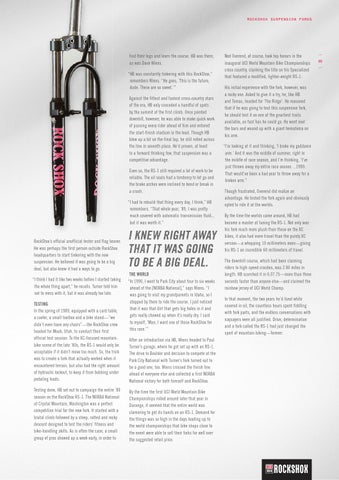ROCKSHOX SUSPENSION FORKS
find their legs and learn the course. HB was there, as was Dave Wiens. “HB was constantly tinkering with this RockShox,” remembers Wiens. “He goes, ‘This is the future, dude. These are so sweet.’” Against the fittest and fastest cross-country stars of the era, HB only conceded a handful of spots by the summit of the first climb. Once pointed downhill, however, he was able to make quick work of passing every rider ahead of him and entered the start-finish stadium in the lead. Though HB blew up a bit on the final lap, he still rolled across the line in seventh place. He’d proven, at least to a forward thinking few, that suspension was a competitive advantage. Even so, the RS-1 still required a lot of work to be reliable. The oil seals had a tendency to let go and the brake arches were inclined to bend or break in a crash. “I had to rebuild that thing every day, I think,” HB remembers. “That whole year, ’89, I was pretty much covered with automatic transmission fluid... but it was worth it.”
RockShox’s official unofficial tester and flag bearer. He was perhaps the first person outside RockShox headquarters to start tinkering with the new suspension. He believed it was going to be a big deal, but also knew it had a ways to go. “I think I had it like two weeks before I started taking the whole thing apart,” he recalls. Turner told him not to mess with it, but it was already too late. TESTING In the spring of 1989, equipped with a card table, a cooler, a small toolbox and a bike stand—”we didn’t even have any chairs”—the RockShox crew headed for Moab, Utah, to conduct their first official test session. To the XC-focused mountainbike scene of the late ‘80s, the RS-1 would only be acceptable if it didn’t move too much. So, the trick was to create a fork that actually worked when it encountered terrain, but also had the right amount of hydraulic lockout, to keep it from bobbing under pedaling loads. Testing done, HB set out to campaign the entire ’89 season on the RockShox RS-1. The NORBA National at Crystal Mountain, Washington was a perfect competition trial for the new fork. It started with a brutal climb followed by a steep, rutted and rocky descent designed to test the riders’ fitness and bike-handling skills. As is often the case, a small group of pros showed up a week early, in order to
THE WORLD “In 1990, I went to Park City about four to six weeks ahead of the [NORBA National],” says Wiens. “I was going to visit my grandparents in Idaho, so I stopped by there to ride the course. I just noticed that it was that dirt that gets big holes in it and gets really chewed up when it’s really dry. I said to myself, ‘Man, I want one of those RockShox for this race.’” After an introduction via HB, Wiens headed to Paul Turner’s garage, where he got set up with an RS-1. The drive to Boulder and decision to compete at the Park City National with Turner’s fork turned out to be a good one, too. Wiens crossed the finish line ahead of everyone else and collected a first NORBA National victory for both himself and RockShox. By the time the first UCI World Mountain Bike Championships rolled around later that year in Durango, it seemed that the entire world was clamoring to get its hands on an RS-1. Demand for the things was so high in the days leading up to the world championships that bike shops close to the event were able to sell their forks for well over the suggested retail price.
Ned Overend, of course, took top honors in the inaugural UCI World Mountain Bike Championships cross country, claiming the title on his Specialized that featured a modified, lighter-weight RS-1. His initial experience with the fork, however, was a rocky one. Asked to give it a try, he, like HB and Tomac, headed for ‘The Ridge’. He reasoned that if he was going to test this suspension fork, he should test it on one of the gnarliest trails available, as fast has he could go. He went over the bars and wound up with a giant hematoma on his arm. “I’m looking at it and thinking, ‘I broke my goddamn arm.’ And it was the middle of summer, right in the middle of race season, and I’m thinking, ‘I’ve just thrown away my entire race season…1990: That would’ve been a bad year to throw away for a broken arm.” Though frustrated, Overend did realize an advantage. He tested the fork again and obviously opted to ride it at the worlds. By the time the worlds came around, HB had become a master at tuning the RS-1. Not only was his fork much more plush than those on the XC bikes, it also had more travel than the purely XC version—a whopping 10 millimeters more—giving his RS-1 an incredible 60 millimeters of travel. The downhill course, which had been claiming riders to high-speed crashes, was 2.86 miles in length. HB scorched it in 6:37.75—more than three seconds faster than anyone else—and claimed the rainbow jersey of UCI World Champ. In that moment, the two years he’d lived while covered in oil, the countless hours spent fiddling with fork parts, and the endless conversations with naysayers were all justified. Drive, determination and a fork called the RS-1 had just changed the sport of mountain biking—forever.
— 65 —
